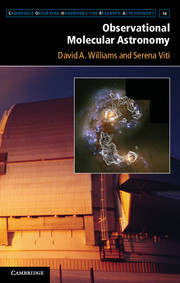Book contents
- Frontmatter
- Contents
- List of Illustrations
- List of Tables
- Preface
- 1 Introduction
- 2 Spectra and Excitation of Interstellar Molecules
- 3 Astrochemical Processes
- 4 Physical Processes in Different Astronomical Environments
- 5 Molecular Tracers in the Milky Way Galaxy
- 6 Molecular Tracers in External Galaxies
- 7 The Early Universe and the First Galaxies
- 8 Recipes for Molecular Submillimetre Astronomy
- 9 Chemical and Radiative Transfer Models
- 10 Observations: Which Molecule, Which Transition?
- Appendix: Acronyms
- Index
- References
1 - Introduction
Published online by Cambridge University Press: 05 December 2013
- Frontmatter
- Contents
- List of Illustrations
- List of Tables
- Preface
- 1 Introduction
- 2 Spectra and Excitation of Interstellar Molecules
- 3 Astrochemical Processes
- 4 Physical Processes in Different Astronomical Environments
- 5 Molecular Tracers in the Milky Way Galaxy
- 6 Molecular Tracers in External Galaxies
- 7 The Early Universe and the First Galaxies
- 8 Recipes for Molecular Submillimetre Astronomy
- 9 Chemical and Radiative Transfer Models
- 10 Observations: Which Molecule, Which Transition?
- Appendix: Acronyms
- Index
- References
Summary
Why Are Molecules Important in Astronomy?
Molecules pervade the cooler, denser parts of the Universe. As a useful rule of thumb, cosmic gases at temperatures of less than a few thousand K and with number densities greater than one hydrogen atom per cm3 are likely to contain some molecules; even the Sun's atmosphere is very slightly molecular in sunspots (where the temperature – at about 3200 K – is lower than the average surface temperature). However, if the gas kinetic temperatures are much lower, say about 100 K or less, and gas number densities much higher, say more than about 1000 hydrogen atoms per cm3, the gas will usually be almost entirely molecular. The Giant Molecular Clouds (GMCs) in the Milky Way and in other spiral galaxies are clear examples of regions that are almost entirely molecular. The denser, cooler components of cosmic gas, such as the GMCs in the Milky Way Galaxy, contain a significant fraction of the nonstellar baryonic matter in the Galaxy. Counterparts of the GMCs in the Milky Way are found in nearby spiral galaxies (see Figure 1.1). Although molecular regions are generally relatively small in volume compared to hot gas in structures such as galactic jets or extended regions of very hot X-ray–emitting gas in interstellar space, their much higher density offsets that disparity, and so compact dense objects may be more massive than large tenuous regions.
- Type
- Chapter
- Information
- Observational Molecular AstronomyExploring the Universe Using Molecular Line Emissions, pp. 1 - 15Publisher: Cambridge University PressPrint publication year: 2013



